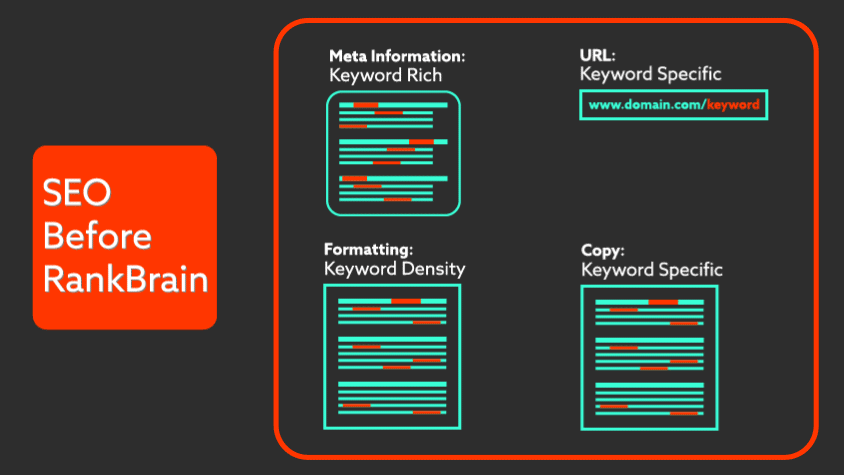
Why Google’s RankBrain is the Best Thing to Happen to SEO
June 18, 2018
By Ken Mafli
In 2015, Google acknowledged that it had released an enhanced ranking system into the wild. But unlike the incremental improvements to the existing ranking algorithm of the past, this was a revolution in that this system used artificial intelligence (AI) to determine how webpages should be ranked.
In the two plus years that RankBrain has been working, it has become clear that some traditional methods of SEO no longer apply. Before we dive into how RankBrain is changing SEO, let’s look at what RankBrain is:
What Is RankBrain
RankBrain is one component of how Google decides how a page should rank. Yes, Google’s ranking algorithm is still in place, using over 200 factors to grade webpages. But with RankBrain, Google can now watch how users interact with a page and judge if that page is truly a good match for a search query.
How It Works
RankBrain collects user experience (UX) data regarding how users interact with the webpages displayed on a search engine results page (SERP). It does this by keeping track of metrics like click-through rate (CTR), bounce rate, time on page, and more.
Here is a quick example, Let’s say you sell red widgets. Google analyzes your product page and places you in the number 10 rank on the SERP page for the search query “bright widgets” (close to “red widgets”). But instead of garnering 1 percent of the clicks (which is the average for the number 10 rank, let’s say), you garner 2 percent. Further, the average bounce rate for your industry is 70 percent and your page tracks at 60 percent. RankBrain, taking notice of your above average metrics, will move you the ninth position. If you continue to outperform other pages and averages, you will continue to rise in the SERP rankings.
What does this mean for SEO? This means, for the first time, Google is judging you on how well you provide the viewer valuable, engaging content. But that is not all. Google is using RankBrain to refine the pages it serves up based on the intent of the query. Here is what I mean:
Let’s say you, as a Google user, type in “Blue Suede Shoes.” You could either be an Elvis fan or a shoe aficionado. Using RankBrain, Google has been watching other users who searched that and other similar queries. It has seen that, over time, users have stayed longer on the pages that talk about Elvis Presley’s famous song. But here is where the magic happens. Since it knows that, it uses machine learning to understand that a page about Elvis Presley’s complete works with a section on Blue Suede Shoes may also be of interest. So even though, from a keyword perspective, the complete works page may be a low match, from a contextual perspective, it is quite high. Therefore, Google has opened up many more opportunities to rank on SERPs.
With RankBrain, to garner organic traffic, you don’t need to focus on just one keyword. In fact, it is better if you don’t. If you focus on a topic instead of a single keyword, traffic from multiple long-tail keywords will be pointed your way.
(below is an animation exploring how RankBrain has changed SEO)

Here are four ways RankBrain has helped those of us who are knee-deep in SEO every day:
It Keeps Us Honest in Optimizing for SERPs
Google’s algorithm has come a long way since the early days. Gone are the days of simple keyword stuffing or writing clumsy content to keep keyword density at the optimal percentage. And while Google’s algorithm has come a long way, it has always played catch-up to the black-hatters.
With RankBrain, you are either giving the viewers what they want or you are not. The UX metrics don’t lie. The better and more engaging your content is, the higher your rankings will be. It is important to note, however, that Google’s algorithm has not gone away. It still looms large in ranking factors. So ignore on-page SEO, social, and backlinking at your own peril. That being said, RankBrain can either give you a boost or slap you down, based on how you are treating the viewer.
It Forces Us to Focus on Concepts, Not Keywords
Let’s face it: Sticking to a single keyword and churning out thousands of words is not a fun task. In fact, I hate it. I would rather have a topic to explore, flesh it out, and let the topic inform my journey as a writer, than have a specific keyword that must be used verbatim.
But now, adhering to one keyword per page is gone. With RankBrain, Google watches the UX of visitors to your webpage. It tracks the different queries that people used to navigate to your page in order to understand which keywords are a best match. Over time, it gets to know your page and funnels highly qualified visitors from a host of keywords. The benefit: It allows us to focus on topics and topic clusters.
To understand topic clusters, look no further than HubSpot. They have done amazing work in the field of topic clusters (they even have a traveling Principal Inbound Professor, Justin Champion, educating audiences on this and other content marketing strategies). Their approach is to create one pillar page that explores a topic in great detail. They then create smaller pages, typically blog posts, that speak to the different facets of the topic. Those supporting pages link to the pillar page and each other. This creates a dense, extremely informative experience for the user. It is a highly effective technique.
RankBrain Encourages Us to Focus on Our Online Brand Reputation
Moz made a great point in a recent post that good SEO should “seek to build your brand’s reputation as a resource trusted by search engines and human users for providing a specific [user] experience.” Going back to our earlier example, if you sell the best red widgets money can buy, that is what you want the world to know you for. With RankBrain, you can communicate that in ways you never could before. By creating pages with a fantastic user experience, as well as additional pages that support each other in a topic cluster, you will quickly garner traffic from people searching for red widgets, no matter what query they use.
In my opinion, RankBrain strips away the games that a lot of us in the industry had to play in order to rank well. Those that will succeed in this new environment are the professionals who will step up and truly give the visitors what they want. And that is great news for marketers and users alike.

About the author
Ken Mafli was formerly a Marketing Consultant. He is a guru of the Inbound methodology but also uses paid search, social media, and PR to achieve overall goals. Read more articles by Ken Mafli.








